Landscape Fragmentation in Qinling–Daba Mountains Nature Reserves and Its Influencing Factors
Abstract
:1. Introduction
2. Study Area and Methods
2.1. Overview of the Study Area
2.2. Data Sources and Processing
2.3. Study Methods
2.3.1. Construction of a Composite Landscape Fragmentation Indicator
2.3.2. Determination of Factors Influencing Landscape Fragmentation
2.3.3. Quantitative Indices of Human Activity Intensity
3. Analysis of Results
3.1. Variation Characteristics of Landscape Fragmentation in Different Types of Nature Reserves
3.2. Core–Edge Spatial Differentiation of Landscape Fragmentation among Nature Reserve Types
3.2.1. Analysis of Landscape Fragmentation in the Interior of the Nature Reserves
3.2.2. Analysis of Landscape Fragmentation at the Edges of Nature Reserves
3.3. Analysis of Influencing Factors
4. Conclusions and Discussion
4.1. Conclusions
4.2. Discussion
Author Contributions
Funding
Institutional Review Board Statement
Informed Consent Statement
Data Availability Statement
Acknowledgments
Conflicts of Interest
References
- Ding, L.; Xu, G.; Lu, J.; Zhang, D.; Fang, B. Landscape fragmentation and its effect on biodiversity. J. Jiangsu For. Sci. Technol. 2005, 32, 45–49. [Google Scholar]
- Evans, M.J.; Banks, S.C.; Driscoll, D.A.; Hicks, A.J.; Melbourne, B.A.; Davies, K.F. Short- and long-term effects of habitat fragmentation differ but are predicted by response to the matrix. Ecology 2017, 98, 807–819. [Google Scholar] [CrossRef] [PubMed]
- Haddad, N.M.; Brudvig, L.A.; Clobert, J.; Davies, K.F.; Gonzalez, A.; Holt, R.D.; Lovejoy, T.E.; Sexton, J.O.; Austin, M.P.; Collins, C.D.; et al. Habitat fragmentation and its lasting impact on Earth’s ecosystems. Sci. Adv. 2015, 1, e1500052. [Google Scholar] [CrossRef] [PubMed] [Green Version]
- Lindenmaver, D.; Fischer, J. Habitat fragmentation and landscape change: An ecological and conservation synthesis. Austral Ecol. 2010, 32, 477–478. [Google Scholar]
- Geldmann, J.; Barnes, M.; Coad, L.; Craigie, I.D.; Hockings, M.; Burgess, N.D. Effectiveness of terrestrial protected areas in reducing biodiversity and habitat loss. Biol. Conserv. 2013, 161, 230–238. [Google Scholar] [CrossRef]
- Watson, J.; Dudley, N.; Segan, D.B.; Hockings, M. The performance and potential of protected areas. Nature 2014, 515, 67–73. [Google Scholar] [CrossRef]
- Zhao, R.; Jiang, P.; Zhao, H.; Fan, J. Fragmentation process of wetlands landscape in the middle reaches of the Heihe River and its driving forces analysis. Acta Ecol. Sin. 2013, 33, 4436–4449. [Google Scholar] [CrossRef] [Green Version]
- Pressey, B.; Mccauley, D.J.; Morgan, L.; Possingham, H.P. A to–do list for the world’s parks. Nature 2014, 515, 28–31. [Google Scholar]
- Wang, Y.; Gao, J.; Wang, J.; Gao, F. Study on ecosystem service values in national nature conservation areas in Guangdong Province from 2000 to 2010. Res. Environ. Sci. 2014, 27, 1157–1163. [Google Scholar]
- Langlois, L.A.; Drohan, P.J.; Brittingham, M.C. Linear infrastructure drives habitat conversion and forest fragmentation associated with Marcellus shale gas development in a forested landscape. J. Environ. Manag. 2017, 197, 167–176. [Google Scholar] [CrossRef] [Green Version]
- Collins, C.D.; Holt, R.D.; Foster, B.L. Patch size effects on plant species decline in an experimentally fragmented landscape. Ecology 2009, 90, 2577–2588. [Google Scholar] [CrossRef] [Green Version]
- Moreiraa, M.; Fonsecabc, C.; Vergílioc, M.; Caladod, H.; Gile, A. Spatial assessment of habitat conservation status in a Macaronesian island based on the InVEST model: A case study of Pico Island (Azores, Portugal). Land Use Policy 2018, 78, 637–649. [Google Scholar] [CrossRef]
- Zhu, J.; Gong, J.; Li, J. Spatiotemporal change of habitat quality in ecologically sensitive areas of eastern Qinghai-Tibet Plateau: A case study of the Hehuang Valley, Qinghai Province. Resour. Sci. 2020, 42, 991–1003. [Google Scholar]
- Yin, K.; Zhao, Q.; Wen, M.; Hua, L.; Lin, T.; Shi, L. Assessment of landscape pattern effect and ecosystem service of island urban forest. Remote. Sens. Land Resour. 2014, 26, 128–133. [Google Scholar]
- Cerrillo, R.M.N.; Vieira, D.J.E.; Ochoa-Gaona, S.; De Jong, B.H.J.; Delgado-Serrano, M.D.M. Land cover changes and fragmentation in mountain neotropical ecosystems of Oaxaca, Mexico under community forest management. J. For. Res. 2019, 30, 143–155. [Google Scholar] [CrossRef]
- Wu, J.; Cao, Q.; Shi, S.; Huang, X.; Lu, Z. Spatio-temporal variability of habitat quality in Beijing–Tianjin–Heibei Area based on land use change. Chin. J. Appl. Ecol. 2015, 26, 3457–3466. [Google Scholar]
- May, F.; Rosenbaum, B.; Schurr, F.M.; Chase, J.M. The geometry of habitat fragmentation: Effects of species distribution patterns on extinction risk due to habitat conversion. Ecol. Evol. 2019, 9, 2775–2790. [Google Scholar] [CrossRef]
- Pfeifer, M.; Lefebvre, V.; Peres, C.; Banks-Leite, C.; Wearn, O.; Marsh, C.; Butchart, S.H.M.; Arroyo-Rodríguez, V.; Barlow, J.; Cerezo, A.; et al. Creation of forest edges has a global impact on forest vertebrates. Nature 2017, 551, 187–191. [Google Scholar] [CrossRef]
- Pfeifer, M.; Lefebvre, V.; Gardner, T.A.; Arroyo-Rodriguez, V.; Baeten, L.; Banks-Leite, C.; Barlow, J.; Betts, M.G.; Brunet, J.; Cerezo, A.; et al. Supporting information for “BIOFRAG—A new database for analyzing biodiversity responses to forest fragmentation”. Ecol. Evol. 2014, 4, 1524–1537. [Google Scholar] [CrossRef] [Green Version]
- Barlow, J.; Lennox, G.D.; Ferreira, J.; Berenguer, E.; Lees, A.C.; Nally, R.M.; Thomson, J.R.; Ferraz, S.F.d.; Louzada, J.; Oliveira, V.H.F.; et al. Anthropogenic disturbance in tropical forests can double biodiversity loss from deforestation. Nature 2016, 535, 144–147. [Google Scholar] [CrossRef] [Green Version]
- Rosa, I.M.D.; Smith, M.J.; Wearn, O.R.; Purvis, D.; Ewers, R.M. The environmental legacy of modern tropical deforestation. Curr. Biol. 2016, 26, 2161–2166. [Google Scholar] [CrossRef] [Green Version]
- Zhang, B.; Zhou, C.; Chen, S. The geo-info-spectrum of montane altitudinal belts in China. Acta Geogr. Sin. 2003, 58, 163–171. [Google Scholar]
- Zhou, Z.; Ren, Z.; Li, J. Study on the ecological value of soil conservation of vegetation in the Qinling-Daba Mountains. Arid. Zone Res. 2006, 1, 144–148. [Google Scholar]
- Li, Y.; Liu, G.; Liu, D.; Qin, Y. Geographical expression and quantitative exploration of the China’s north-south transitional zone. Geogr. Res. 2021, 40, 1857–1869. [Google Scholar]
- Zhao, F.; Zhang, B.; Zhu, L.; Yao, Y.; Cui, Y.; Liu, J. Spectra structures of altitudinal belts and their significance for determining the boundary between warm temperate and subtropical zones in the Qinling-Daba Mountains. Acta Geogr. Sin. 2019, 74, 889–901. [Google Scholar]
- Zhang, J.; Li, Y.; Zhu, L. Relief amplitude based on county units in west Henan Mountain area and its correlation with distribution of population and economic activities. Areal Res. Dev. 2019, 38, 55–60. [Google Scholar]
- Tang, J.; Tan, F.; Zhou, L. Analysis on the influence of landscape fragmentation on species diversity. J. Green Sci. Technol. 2018, 24, 158–161. [Google Scholar]
- Dong, Y.; Liu, S.; An, N.; Yin, Y.; Wang, J.; Qiu, Y. Landscape pattern in Da’an City of Jilin Province based on landscape indices and local spatial autocorrelation analysis. J. Nat. Resour. 2015, 30, 1860–1871. [Google Scholar]
- Wu, J. Landscape Ecology: Pattern, Process, Scale and Hierarchy; Higher Education Press: Beijing, China, 2007. [Google Scholar]
- Wan, J.; Xu, C. Geodetector: Principle and prospective. Acta Geogr. Sin. 2017, 72, 116–134. [Google Scholar]
- Xie, Y.; Gong, J.; Qi, S.; Zhang, Y.; Guo, J. Assessment of ecosystem food production and its spatiotemporal heterogeneity in the Bailong River Watershed, Gansu. Acta Ecol. Sin. 2017, 37, 1719–1728. [Google Scholar]
- Xu, Y.; Xu, X.; Tang, Q. Human activity intensity of land surface: Concept, method and application in China. J. Geogr. Sci. 2016, 26, 1349–1361. [Google Scholar] [CrossRef]
- Sun, B.; Duan, W.; Ding, H.; Feng, Y.; Wen, Y. Preference analysis of household ecological compensation in Crested Ibis protected area in Hanzhong, Shaanxi based on choice experiments. Resour. Sci. 2017, 39, 1792–1800. [Google Scholar]
- Pereira, H.M.; Leadley, P.W.; Proençarob, V.; Scharlemann, A.P.W.; Fernandez-Manjarrés, J.F.; Araújo, M.B.; Balvanera, P.; Biggs, R.; Cheung, W.W.L.; Chini, L.; et al. Scenarios for global biodiversity in the 21st century. Science 2010, 330, 1496–1501. [Google Scholar] [CrossRef] [PubMed] [Green Version]
- Staudinger, M.D.; Carter, S.L.; Cross, M.S.; Dubois, N.; Duffy, J.E.; Enquist, C.; Griffis, R.; Hellmann, J.J.; Lawler, J.J.; O’Leary, J.; et al. Biodiversity in a changing climate: A synthesis of current and projected trends in the US. Front. Ecol. Environ. 2013, 11, 465–473. [Google Scholar] [CrossRef] [Green Version]
- Morgine, M.; Jetz, W. The effect of range changes on the functional turnover, structure and diversity of bird assemblages under future climate scenarios. Glob. Chang. Biol. 2015, 21, 2917–2928. [Google Scholar]
- Araújo, M.B.; Alagador, D.; Cabeza, M.; Nogués-Bravo, D.; Thuiller, W. Climate change threatens European conservation areas. Ecol. Lett. 2011, 14, 484–492. [Google Scholar] [CrossRef] [Green Version]
- Zhang, J.Q.; Gong, J.; Liu, D.Q. Dynamics and driving factors of landscape fragmentation based on Geodetector in the Bailongjiang watershed of Gansu Province. Sci. Geogr. Sin. 2018, 38, 1370–1378. [Google Scholar]
- Jin, C.P.; Wang, C.; Wen, R.H.; Hou, P. Analysis of land cover change in Danjiang Wetland National Nature Reserve and its inner and outer areas from 2000 to 2015. Environ. Monit. Early Warn. 2019, 11, 8–13. [Google Scholar]
- Yan, W.W. Study on the status quo and management measures of ecotourism in Taibai Mountain Nature Reserve. J. Green Sci. Technol. 2020, 21, 214–217. [Google Scholar]
- Jackson, S.T.; Sax, D.F. Balancing biodiversity in a changing environment: Extinction debt, immigration credit and species turnover. Trends Ecol. Evol. 2010, 25, 153–160. [Google Scholar] [CrossRef]
- Tilman, D.; May, R.M.; Lehman, C.L.; Nowak, M.A. Habitat destruction and the extinction debt. Nature 1994, 371, 65–66. [Google Scholar] [CrossRef]
- Damschen, E.I.; Drudvig, L.A. Landscape connectivity strengthens local–regional richness relationships in successional plant communities. Ecology 2012, 93, 704–710. [Google Scholar] [CrossRef] [Green Version]
- Zhu, P.; Huang, L.; Xiao, T.; Wang, J. Dynamic changes of habitats in China’s typical nature reserves on spatial and temporal scales. Acta Geogr. Sin. 2018, 73, 92–103. [Google Scholar] [CrossRef] [Green Version]
- Dobrowski, S.Z.; Littlefield, C.E.; Lyons, D.S.; Hollenberg, C.; Carroll, C.; Parks, S.A.; Abatzoglou, J.T.; Hegewisch, K.; Gage, J. Protected-area targets could be undermined by climate change-driven shifts in ecoregions and biomes. Commun. Earth Environ. 2021, 2, 198. [Google Scholar] [CrossRef]
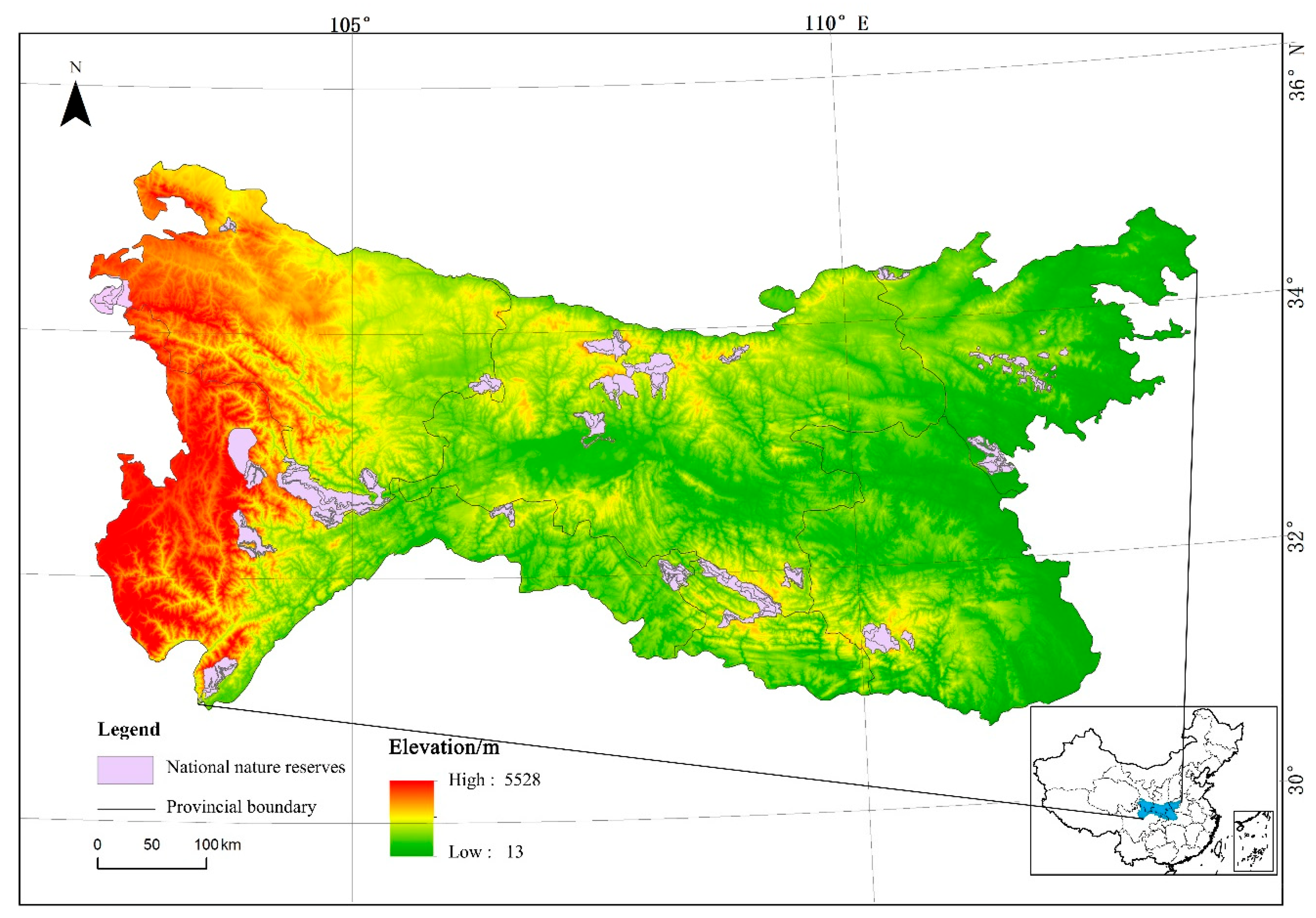

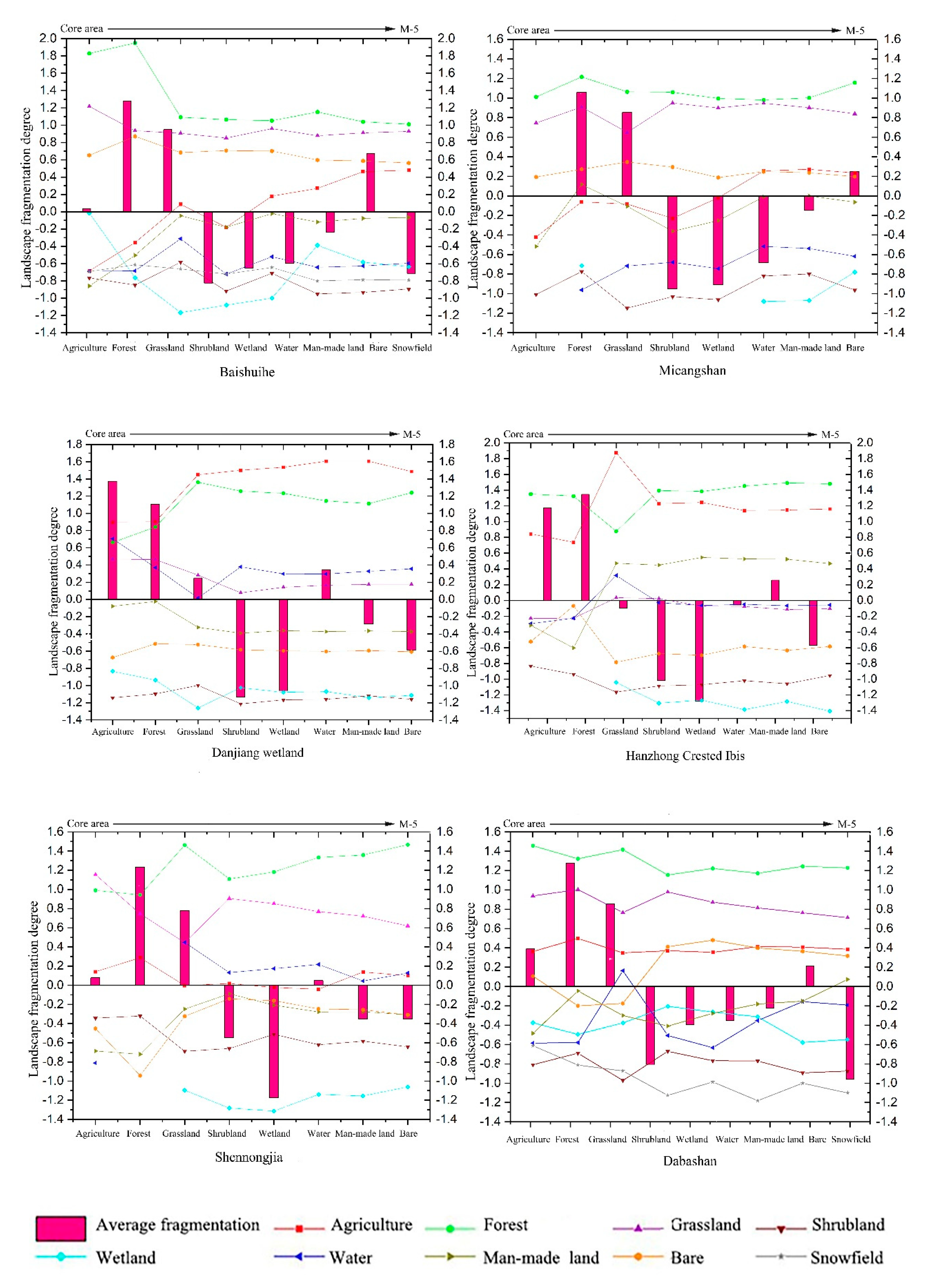

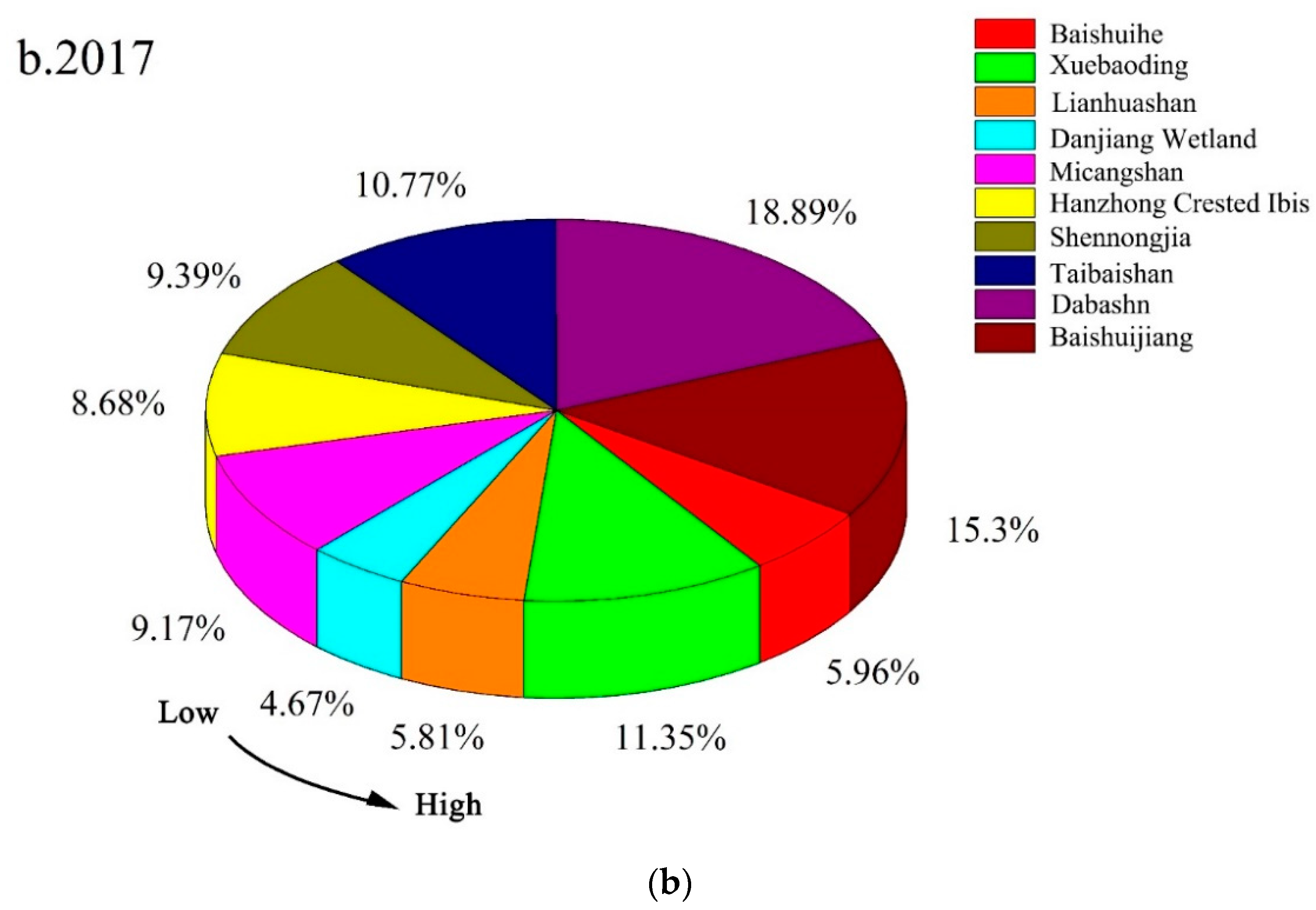
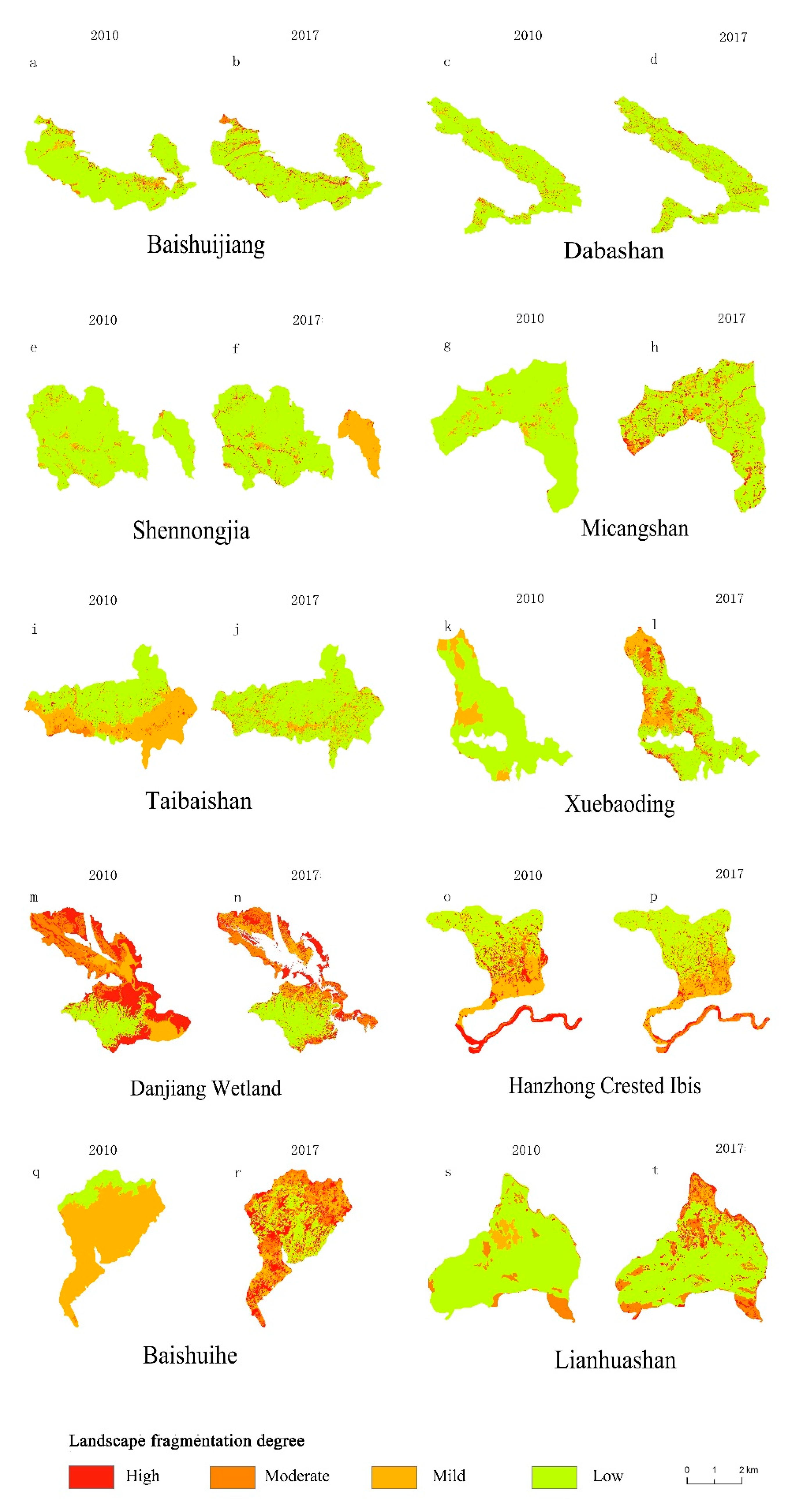
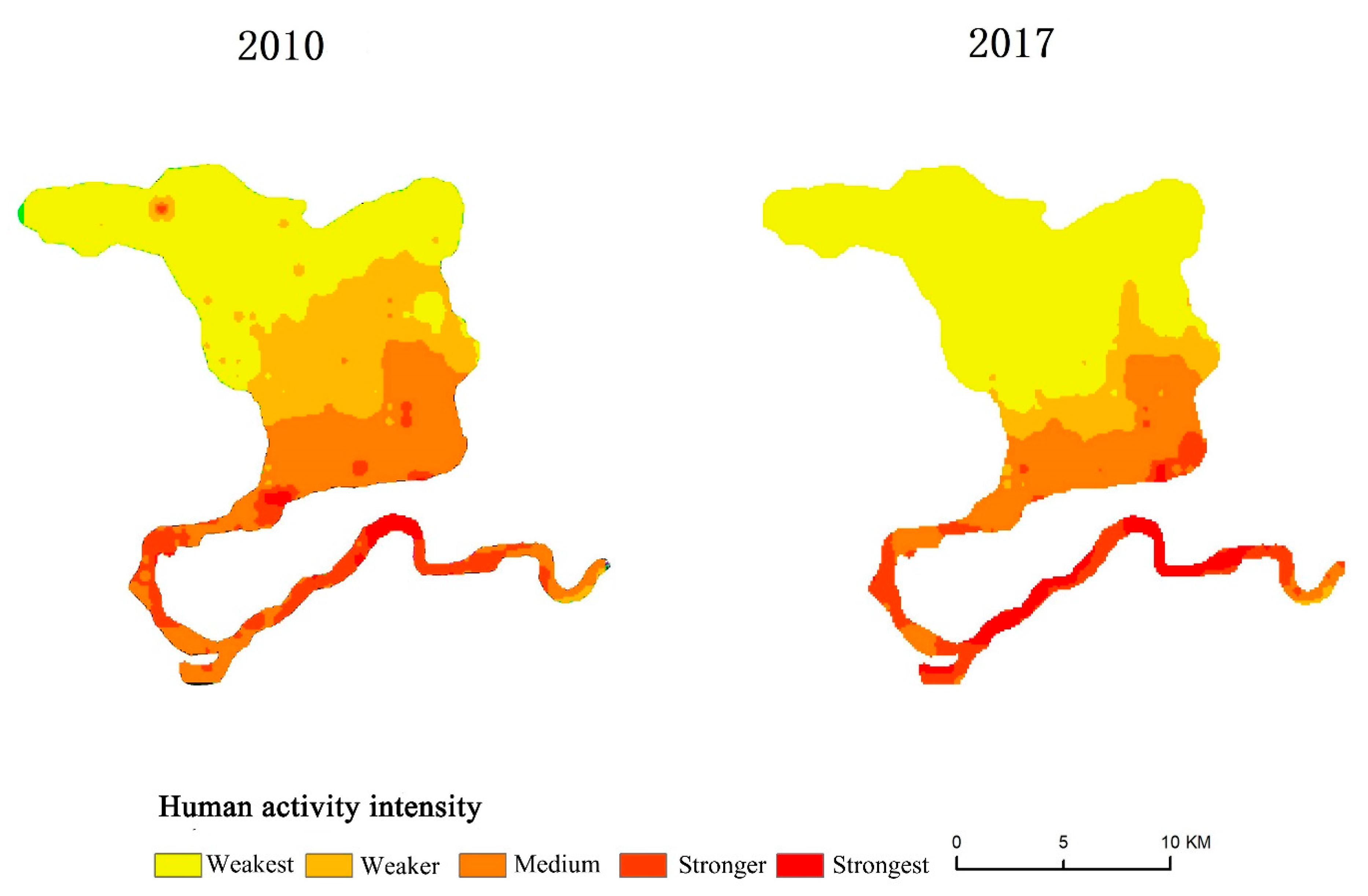
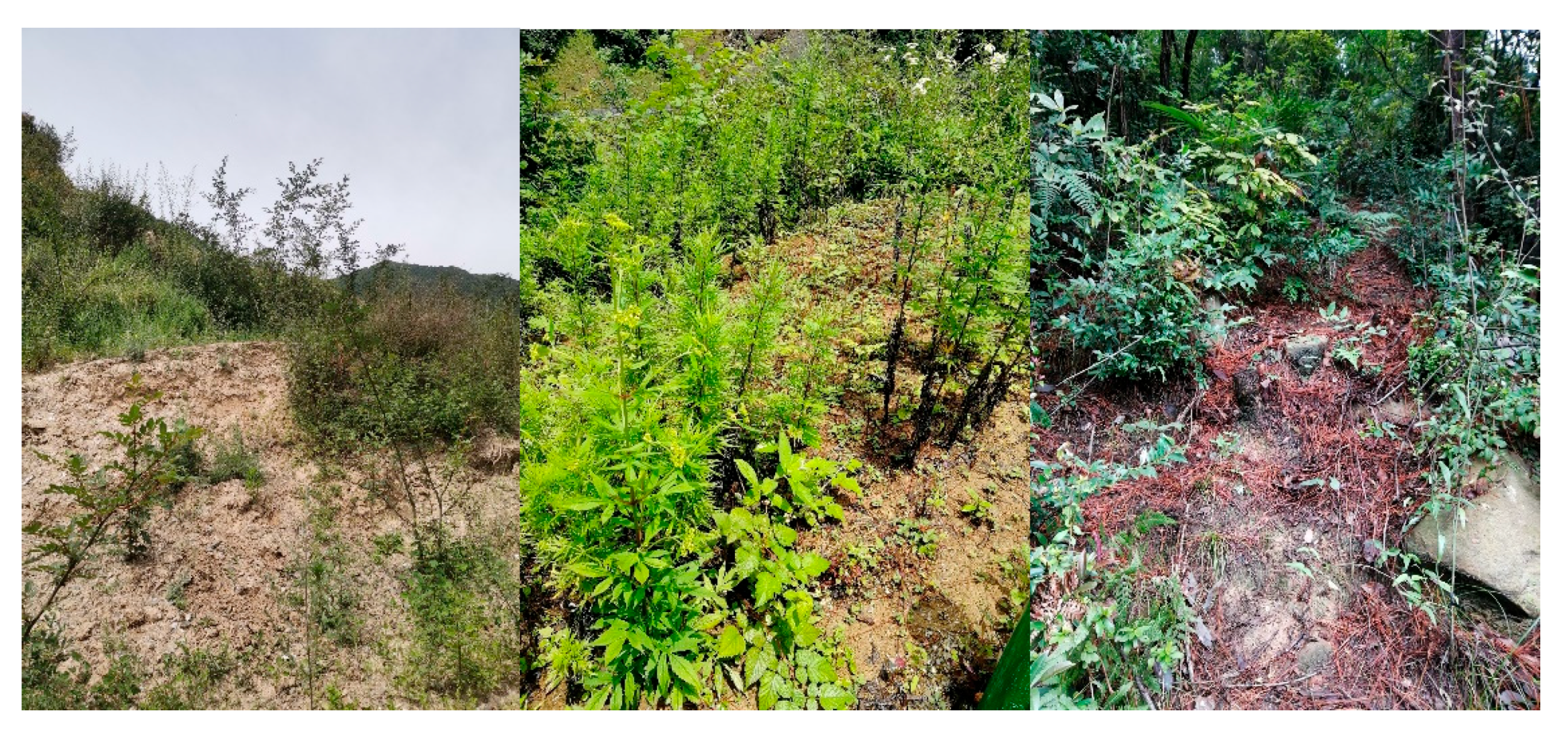
| Year | KMO | Bartlett’s Test (sig) | Nature Reserve | Common Factor Variance | Cumulative Variance Contribution Rate /% | Number of Principal Components |
|---|---|---|---|---|---|---|
| Initial Value | ||||||
| 2010 | 0.590 | 0.000 | Baishuijiang | 1.000 | 87.196 | 3 |
| 0.589 | 0.000 | Dabashan | 1.000 | 72.862 | 2 | |
| 0.620 | 0.000 | Shennongjia | 1.000 | 73.957 | 2 | |
| 0.552 | 0.000 | Micangshan | 1.000 | 72.815 | 2 | |
| 0.569 | 0.000 | Taibaishan | 1.000 | 72.905 | 2 | |
| 0.538 | 0.000 | Xuebaoding | 1.000 | 73.773 | 2 | |
| 0.623 | 0.000 | Danjiang Wetland | 1.000 | 71.791 | 2 | |
| 0.597 | 0.000 | Hanzhong Crested Ibis | 1.000 | 90.134 | 3 | |
| 0.578 | 0.000 | Baishuihe | 1.000 | 76.367 | 2 | |
| 0.630 | 0.000 | Lianhuashan | 1.000 | 72.279 | 2 | |
| 2017 | 0.578 | 0.000 | Baishuijiang | 1.000 | 72.176 | 2 |
| 0.550 | 0.000 | Dabashan | 1.000 | 74.043 | 2 | |
| 0.596 | 0.000 | Shennongjia | 1.000 | 71.768 | 2 | |
| 0.561 | 0.000 | Micangshan | 1.000 | 73.891 | 2 | |
| 0.586 | 0.000 | Taibaishan | 1.000 | 72.162 | 2 | |
| 0.576 | 0.000 | Xuebaoding | 1.000 | 72.302 | 2 | |
| 0.586 | 0.000 | Danjiang Wetland | 1.000 | 71.797 | 2 | |
| 0.621 | 0.000 | Hanzhong Crested Ibis | 1.000 | 73.027 | 2 | |
| 0.547 | 0.000 | Baishuihe | 1.000 | 74.583 | 2 | |
| 0.592 | 0.000 | Lianhuashan | 1.000 | 71.319 | 2 |
| Land-Use/Cover Type | Agricultural Land | Woodland and Shrubland | Grasslands | Wetland and Water Areas | Land for Man-Made Facilities | Bare Land and Snowfields |
|---|---|---|---|---|---|---|
| Conversion coefficient | 0.2 | 0.0 | 0.067 | 0.6 | 1.0 | 0.0 |
| Year | Patch Index | Baishuijiang | Dabashan | Shennongjia | Micangshan | Taibaishan | Xuebaoding | Danjiang Wetland | Hanzhong Crested Ibis | Baishuihe | Lianhuashan |
|---|---|---|---|---|---|---|---|---|---|---|---|
| 2010 | PA/ha | 143.55 | 111.20 | 50.70 | 21.15 | 18.40 | 47.22 | 4.77 | 11.06 | 21.98 | 7.20 |
| PSI | 1.38 | 1.34 | 1.13 | 1.23 | 1.22 | 1.60 | 1.43 | 1.42 | 1.59 | 1.54 | |
| FRAC | 1.24 | 1.25 | 1.20 | 1.18 | 1.23 | 1.13 | 1.17 | 1.25 | 1.12 | 1.16 | |
| CONTIG | 0.96 | 0.94 | 0.96 | 0.96 | 0.91 | 0.99 | 0.79 | 0.74 | 0.99 | 0.94 | |
| ENN/m | 65.79 | 71.84 | 67.02 | 66.18 | 67.93 | 676.98 | 97.76 | 100.85 | 69.26 | 76.43 | |
| 2017 | PA/ha | 132.97 | 107.5 | 49.63 | 14.33 | 35.62 | 30.20 | 3.95 | 12.20 | 2.62 | 5.77 |
| PSI | 1.23 | 1.22 | 1.31 | 1.25 | 1.20 | 1.21 | 1.30 | 1.17 | 1.25 | 1.25 | |
| FRAC | 1.25 | 1.30 | 1.22 | 1.27 | 1.20 | 1.28 | 1.14 | 1.27 | 1.18 | 1.22 | |
| CONTIG | 0.87 | 0.87 | 0.94 | 0.77 | 0.83 | 0.80 | 0.80 | 0.79 | 0.49 | 0.75 | |
| ENN/m | 59.75 | 64.19 | 64.75 | 68.95 | 80.21 | 68.35 | 55.65 | 76.93 | 74.73 | 70.34 |
| Influencing Factor | Human Activity Intensity | Topographic Relief | Land-Use Type | Slope Gradient | Elevation |
|---|---|---|---|---|---|
| q-statistic | 0.384 | 0.323 | 0.478 | 0.254 | 0.351 |
| Significance q | 0.000 | 0.000 | 0.000 | 0.000 | 0.000 |
| Influencing Factor | Human Activity Intensity | Topographic Relief | Land-Use Type | Slope Gradient | Elevation |
|---|---|---|---|---|---|
| Human Activity Intensity | 0.384 | ||||
| Topographic Relief | 0.442 | 0.323 | |||
| Land-Use Type | 0.681 | 0.576 | 0.478 | ||
| Slope Gradient | 0.450 | 0.364 | 0.527 | 0.254 | |
| Elevation | 0.471 | 0.392 | 0.549 | 0.373 | 0.351 |
Publisher’s Note: MDPI stays neutral with regard to jurisdictional claims in published maps and institutional affiliations. |
© 2021 by the authors. Licensee MDPI, Basel, Switzerland. This article is an open access article distributed under the terms and conditions of the Creative Commons Attribution (CC BY) license (https://creativecommons.org/licenses/by/4.0/).
Share and Cite
Zhang, Y.; Yin, H.; Zhu, L.; Miao, C. Landscape Fragmentation in Qinling–Daba Mountains Nature Reserves and Its Influencing Factors. Land 2021, 10, 1124. https://doi.org/10.3390/land10111124
Zhang Y, Yin H, Zhu L, Miao C. Landscape Fragmentation in Qinling–Daba Mountains Nature Reserves and Its Influencing Factors. Land. 2021; 10(11):1124. https://doi.org/10.3390/land10111124
Chicago/Turabian StyleZhang, Yingzhuo, Haoran Yin, Lianqi Zhu, and Changhong Miao. 2021. "Landscape Fragmentation in Qinling–Daba Mountains Nature Reserves and Its Influencing Factors" Land 10, no. 11: 1124. https://doi.org/10.3390/land10111124
APA StyleZhang, Y., Yin, H., Zhu, L., & Miao, C. (2021). Landscape Fragmentation in Qinling–Daba Mountains Nature Reserves and Its Influencing Factors. Land, 10(11), 1124. https://doi.org/10.3390/land10111124






